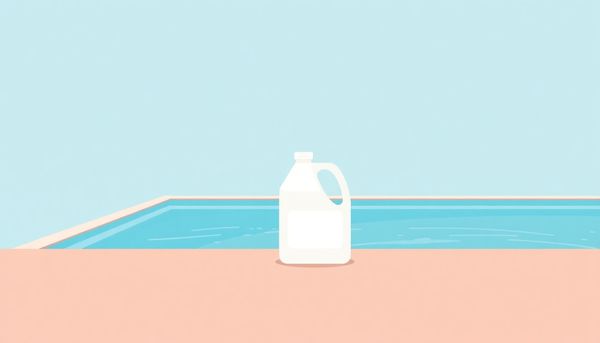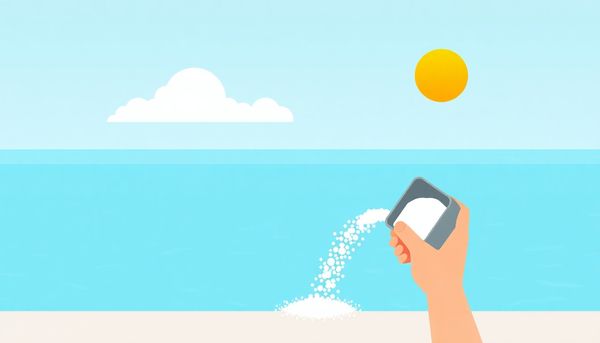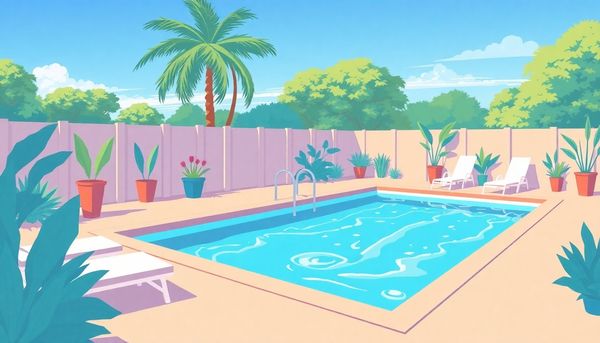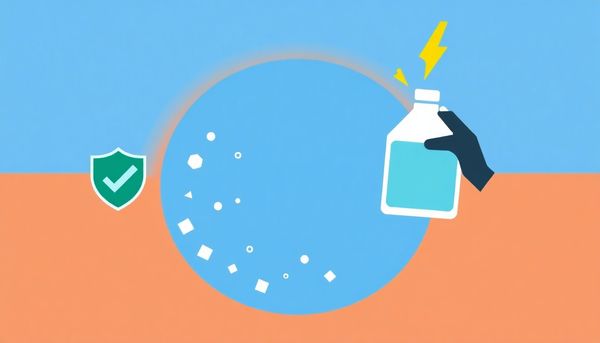Essential Guide to Mastering Effective Pool Shock Maintenance
July 19th, 2024
July 19th, 2024
On a sun-drenched afternoon, there's nothing quite like cannonballing into the refreshing waters of your home pool. However, behind every splash and laughter-filled day lies a lesser-known protagonist: pool shock. This chemical agent plays a crucial role in maintaining the health and clarity of your pool, ensuring that your backyard oasis remains as inviting as ever. Yet, determining just how much shock to add can often feel like solving a mystery.
When I first became a pool owner, I was intrigued by the idea that something as seemingly straightforward as a chlorine compound could make such a difference. My initial attempts at maintaining that crystal-clear water involved guesswork and occasional frustration. I quickly learned that the science behind pool shock isn't just about dumping in chemicals; it's about understanding your pool's specific needs. Factors such as pool size, current chemical levels, and even recent weather patterns come into play.
Implementing the right amount of shock is not merely about following instructions on a label. It's about gaining insight into the rhythm of your pool's needs, much like tending to a garden. This introduction serves as your guide to mastering that balance, ensuring that your pool remains a safe, enjoyable haven for all your summertime adventures. So, how do you find that perfect equilibrium? Let's unravel the secrets together.

Determining how much shock your pool requires can seem like deciphering a complex puzzle. Each piece—whether it's the pool size, type of shock, or the problem at hand—must be considered. For routine maintenance, a rule of thumb suggests using one pound of shock for every 10,000 gallons of water. However, if you're dealing with persistent algae blooms or murky water, this standard guideline might need some adjusting.
Back when a friend of mine hosted a weekend pool party, the aftermath was a cloudy surprise, indicating the need for a serious shock treatment. In cases like these, calculating the right amount of shock can feel daunting, but it’s crucial to restoring that sparkling blue allure. Pool shock types vary, each with unique properties: Cal-hypo for a robust chlorine kick, Dichlor for a stable daytime option, and non-chlorine for gentler, routine applications. Each choice impacts the water differently, and knowing your pool’s needs helps you decide.
Before you start, test your pool's water chemistry. Keep pH levels between 7.4 and 7.6 for optimal results. Also, factor in calcium hardness and cyanuric acid levels which can influence the efficiency of certain shocks. Remember, it’s better to lean slightly on the higher side of calculation to ensure thorough sanitization. When algae or bacteria are the culprits, more shock might be necessary. Ultimately, balancing pool shock is a bit like learning to dance with water chemistry—practice makes perfect, and your pool will thank you every time.
Determining the right amount of pool shock involves more than just tossing chemicals into the water. At the heart of it lies the need to accurately assess your pool’s size and type, as these factors significantly influence the dosage required. A miscalculation can lead to either ineffective treatment or over-chlorination, which might keep you out of the pool longer than planned.
First, understanding your pool’s volume is fundamental. Pools come in all shapes and sizes, from modest backyard oases to expansive community lagoons. Knowing whether you have 10,000 or 20,000 gallons of water changes how much shock you’ll need. Calculating the volume typically involves some basic math: length times width times average depth, adjusted by a multiplier specific to your pool’s shape. If numbers aren’t your strong suit, consider using online calculators designed for this task.
Beyond size, the pool type—be it saltwater, freshwater, or even above-ground—dictates the kind of shock you should use. For example, cal-hypo shock is potent but might not be ideal for saltwater pools due to its calcium content. Meanwhile, non-chlorine shock offers a milder alternative for those seeking routine maintenance without impacting chemical levels too much.
By taking the time to measure and identify your pool’s specifics, you ensure each shock treatment is effective and safe, keeping your water pristine and swim-ready.
Selecting the ideal shock for your pool is akin to choosing the right tool for a job—each has its purpose and specific scenario where it shines. Imagine you've battled algae before, only to find that your usual approach barely dents the problem. Enter cal-hypo shock, a powerful option ideal for when algae seems invincible. This type of shock packs a punch with its high chlorine content, but it demands respect: always apply at night to avoid UV degradation, and give it at least eight hours before diving in again.
Now, if you're managing a smaller pool or a saltwater setup, dichlor shock might be your ally. It doesn’t just combat bacteria and algae; it also stabilizes well in sunlight due to its cyanuric acid content. Still, be wary of its potential to increase your CYA levels over time. On the flip side, for those who prefer a gentler touch, non-chlorine shock is like a soft reset for your water chemistry. Perfect for routine maintenance, it freshens up your pool without tinkering too much with chemical balances.
Each shock type has its quirks—whether it's cal-hypo's calcium content potentially causing scale or dichlor's influence on CYA levels. My go-to solution is to always check the packaging for specifics and align with my pool's unique needs. With these options in your arsenal, managing water conditions becomes less of a chore and more of an informed choice.
Handling pool chemicals is a task that demands both awareness and respect for safety guidelines. When it comes to pool shock, the power of concentrated chlorine ensures that your pool stays clear and clean, but it also requires careful handling to protect both you and your pool. First and foremost, personal protective equipment is non-negotiable. Gloves, goggles, and long-sleeved clothing serve as your first line of defense against chemical burns and irritations.
Before you even begin the process of shocking, understanding the specific product instructions is crucial. Each type of shock—be it cal-hypo, dichlor, or non-chlorine—has its unique set of instructions and requirements for ideal application. For instance, some require dilution in water before adding to the pool, which minimizes the potential for a concentrated clump that could damage your pool lining.
Furthermore, timing plays a critical role. Shocking at night can prevent chlorine degradation by the sun’s ultraviolet rays, especially if you’re using unstabilized chlorine. Also, ensure your pool’s filtration system is running during and after shocking. This not only helps in dispersing the chemicals evenly but also aids in speeding up the process of returning to safe swimming conditions. Lastly, never underestimate the importance of testing the water before and after shocking. Monitoring pH and chlorine levels ensures you achieve the desired cleanliness without risking over-shocking, which can delay safe swimming.

Algae, the uninvited guest in your pool, can be more than just an aesthetic nuisance; it’s a sign of imbalance in your water chemistry. My friend Sarah once called me in a panic when her pool turned green overnight. The culprit? Algae. To combat this effectively, you'll need more than just regular maintenance shock—it's time for a serious intervention.
The first line of defense against algae is to understand the type of shock best suited for your pool’s needs. Cal-hypo shock, known for its potent chlorine content, is a popular choice. It’s particularly effective against stubborn algae blooms. However, if your pool is saltwater, be mindful of scale buildup due to its calcium content. For a more versatile option, dichlor shock offers stabilization benefits, meaning it won’t be quickly depleted by sunlight. This makes it suitable for daytime use in sunny climates.
Sarah found success by doubling the shock dosage for her 10,000-gallon pool, pushing the free chlorine levels to 30 parts per million (ppm) necessary to achieve breakpoint chlorination. This threshold is crucial for annihilating algae effectively. Remember, patience is key—let your filter run continuously for at least 24 hours. If Sarah taught me anything, it’s that persistence pays off. By carefully following shock instructions and keeping the filter humming, her pool was crystal clear within days. So, if you notice that green tinge, gear up with the right shock treatment and reclaim your pool space.
Choosing the right type of pool shock is like selecting the perfect tool for a job — using the wrong one can make things much tougher. With several types available, each serves a distinct purpose and can affect your pool differently. Let's unravel the mystery behind them, helping you make an informed choice.
Calcium hypochlorite, or cal-hypo shock, stands as a powerful contender for battling stubborn algae and bacteria. This potent, unstabilized chlorine option is ideal for pools facing significant contamination issues. However, cal-hypo does have its quirks. It can lead to calcium scaling, particularly in pools with a saltwater system, and should be used at night to avoid degradation from the sun’s rays.
On the other hand, dichlor shock is your go-to for a more balanced approach. Being a stabilized chlorine, it contains cyanuric acid, protecting chlorine from sunlight and making it suitable for daytime use. It’s less harsh on your pool's chemistry, but be mindful of its potential to raise CYA levels over time.
Then there’s the non-chlorine shock, a gentler choice for routine maintenance. It won’t influence calcium or CYA levels and allows swimming shortly after application. While perfect for regular upkeep, it’s not the best choice for severe algae problems as it lacks sanitizing power.
Understanding these differences can save you time and frustration. By choosing the appropriate shock type for your pool’s specific needs, you maintain a healthy and inviting swimming environment, free from unwanted surprises.
Tackling the task of shocking your pool requires not just knowing the right amount, but also understanding the nuances of when and how to apply it for maximum effectiveness. Start by assessing your pool's condition. Is it a routine maintenance shock, or are you battling a green menace? Standard upkeep usually calls for one pound of shock per 10,000 gallons. However, algae infestations are more demanding, potentially requiring two to four times that amount.
Choosing the right type of shock is crucial. Cal-hypo, known for its potency, is your ally against stubborn algae but be cautious with saltwater pools due to potential scale buildup. Dichlor shock, with its stabilizing properties, is perfect for daytime use, balancing chlorine levels without impacting scaling. For frequent maintenance, non-chlorine shock offers gentle treatment, allowing you to swim soon afterward, though it won’t tackle severe algae.
Preparation is key. Test your water to ensure pH levels are between 7.4 and 7.6, optimizing the shock's effectiveness. Protect yourself with goggles and gloves, and follow product instructions meticulously. Whether it's directly adding shock to the pool or pre-mixing it in a bucket, even distribution is essential, so focus on the deep end first and brush thoroughly.
Once the shock is in, patience and filtration are your friends. Run your filter system for at least 24 hours if combating algae, and remember, a cloudy pool means progress—dead algae are on the move. Pool care is as much about precision as it is about timing; allow chlorine levels to stabilize before taking the plunge again.
For pristine pool waters, one must consider not only the immediate treatment of algae but also its prevention. Algaecides serve as a proactive measure, keeping algae at bay before they become a nuisance. Think of algaecide as a guardian, standing watch to ensure your pool remains clear and inviting. Unlike the intense intervention of pool shock, algaecide acts subtly, maintaining a protective barrier that hinders algae blooms from gaining a foothold.
While shocking involves a significant chlorine boost, it’s akin to a blitz against existing algae. Algaecide, on the other hand, works gently over time. Regular applications, especially in the warmer months or after heavy rainfall, can keep potential algae issues from escalating. When I first started maintaining my pool, I quickly learned the importance of routine algaecide use—particularly after a bout of green water that caught me off guard post-storm. That experience taught me that prevention is as crucial as treatment.
It's essential to incorporate algaecide into your pool care routine, complementing the use of shock. A good practice is to add algaecide after each pool shock treatment, once the chlorine levels have normalized. This ensures a multi-layered defense, combining immediate intervention with long-term protection. By integrating algaecide into your maintenance schedule, you safeguard your pool against unsightly algae, ensuring your water stays clear and enjoyable.
Navigating the options for pool shock might feel like wandering through a maze of chemical choices, but pinpointing the right one can make all the difference for your backyard oasis. Each type of pool shock has its strengths, and selecting the appropriate one depends largely on your pool's needs and your own circumstances.
Start by understanding the condition of your water. A crystal clear pool for routine maintenance will benefit from a gentler touch like a non-chlorine shock. This variant is perfect for regular upkeep, allowing for immediate swimming and maintaining balanced water chemistry.
When algae crashes the party, however, a more powerful solution is required. Calcium hypochlorite, or cal-hypo, stands out in tackling stubborn algae blooms. It delivers a potent punch of chlorine, effectively sanitizing the water. Yet, it comes with a caveat: cal-hypo can lead to calcium build-up, especially in saltwater pools. It’s best used at night due to its vulnerability to sunlight.
For those managing cyanuric acid levels, dichlor shock offers a stabilizing effect. This option works well both for routine and rigorous algae control, without the risk of scale accumulation. Plus, it can be used during daylight hours—a bonus for those who prioritize convenience.
Remember, the key isn't just in choosing the shock but in applying it correctly. Always follow the package instructions and consider your pool’s unique ecosystem. Balancing efficacy with chemical balance ensures your pool remains a pristine, inviting retreat.
Choosing the right shock type for your pool can feel like navigating a maze, but it’s crucial for maintaining sparkling blue water. Each pool shock type serves its own purpose, and the decision hinges on your pool’s current needs. If your pool's hosting an algae party, Cal-Hypo shock is your go-to. Known for its high chlorine content, it’s a heavyweight in battling stubborn algae blooms. Just remember, it can cause scale buildup in saltwater systems, so use with caution.
For routine maintenance or less severe algae issues, Dichlor shock might be your best bet. It offers the benefit of stabilized chlorine, meaning it won’t vanish under the sun’s glare as quickly as Cal-Hypo. Plus, it’s gentler on your pool’s chemistry, though you should monitor cyanuric acid levels, as Dichlor will increase them.
Non-chlorine shock, meanwhile, acts more like a friendly nudge than a stern reprimand. Ideal for regular, mild upkeep, it won’t disrupt calcium or cyanuric acid levels and allows swimmers back in the water sooner. However, don’t expect it to tackle tough algae infestations—it’s an oxidizer, not a sanitizer.
Deciding on the right shock is akin to choosing the right tool for a job—it requires understanding your pool’s specific conditions. With these options at your disposal, matching the shock to your pool’s needs becomes a straightforward task, ensuring pristine water all season long.
Algae in a pool is like an unwelcome guest that overthrows your backyard oasis. When it takes hold, a simple one-pound shock per 10,000 gallons just won’t cut it. It’s time to bring out the big guns. An effective treatment involves dosing your pool with a substantial amount of chlorine to achieve what’s known as breakpoint chlorination. This level, around 30 parts per million of chlorine, is necessary to obliterate algae, contaminants, and chloramines.
Jumpstarting the battle against algae, choose a robust option such as calcium hypochlorite, often hailed as the powerhouse of pool shocks. Its high chlorine content makes it particularly adept at eradicating these pesky invaders. However, be wary of its potential to cause scale buildup. If you own a saltwater pool, you might opt for dichlor shock instead, which is less aggressive on your system and can be administered during the day.
Once you’ve selected your shock, calculate your dosage carefully. In cases of severe algae infestation, you might need to triple or even quadruple your standard shock amount. Don't fret if your calculations seem daunting; it’s better to err on the side of caution and add a bit extra, ensuring that the algae doesn’t stand a chance. After shocking, keep the pool pump running and wait at least eight hours before taking a dip. Checking the chlorine levels afterward is crucial to ensure they return to a safe range, allowing you to reclaim your pristine pool.
Routine maintenance is the secret ingredient to a sparkling pool, much like tending to a garden yields vibrant blooms. A well-maintained pool not only looks beautiful but stays safe and inviting for all swimmers. The key is consistency—just as you wouldn't skip watering your plants, don't skip out on regular pool care. A balanced routine ensures that when you're adding shock, you're enhancing an already healthy system, not firefighting a crisis.
Start by testing your water regularly. This isn't just about numbers; it's about understanding your pool's unique needs. Whether you're using strips or a digital tester, knowledge of your pool's chemistry—pH, chlorine levels, and CYA—is crucial. From personal experience, taking a few minutes each week to assess these levels can save hours of hassle later. Trust me, it's easier to prevent than to cure.
Once you’ve got the hang of testing, equip yourself with the right tools. Protective gear is non-negotiable: goggles, gloves, and long-sleeved clothing protect you from the chemical splash-back. Then, follow the manufacturer’s instructions as if they were secret recipes passed down through generations. Different shocks have different quirks, from needing to be pre-mixed in water to specific dosages based on your pool's volume.
Lastly, always circulate your water well post-shock. Running the filter after application ensures even distribution and efficacy. It's like stirring a pot to blend flavors evenly. Remember, maintenance isn’t a chore—it's your routine to keep the pool happy and healthy.

Understanding breakpoint chlorination can transform your pool maintenance routine from guessing games to precision care. This chemical milestone is where chlorine levels become potent enough to obliterate algae, bacteria, and the notorious chloramines that can cloud your pool’s reputation. Imagine aiming for a target, and knowing exactly how many arrows to pull from your quiver—that’s the clarity breakpoint chlorination brings.
Achieving this involves boosting your pool’s chlorine to ten times the level of combined chlorine present in the water. For most pools, this means reaching a chlorine concentration of around 30 parts per million. The journey to this point depends on multiple factors, like your pool’s size, water temperature, and existing water chemistry. If your pool has higher pH levels or elevated cyanuric acid, you may need to adjust the amount of shock you use.
In my own backyard oasis, I remember the first summer we tackled a persistent algae bloom. With meticulous testing and a night of cal-hypo shock, the pool was crystal clear by morning. It underscored the importance of timing and correct dosage. For those navigating these waters for the first time, keep a test kit handy and don’t skimp on the shock. Your diligence pays off when you see your pool return to its sparkling glory.
Choosing the right type of pool shock can be akin to picking the right tool out of a toolbox. Each type of shock has unique properties and is suited for different situations, much like choosing between a hammer and a screwdriver. Cal-hypo shock, for example, is the go-to option when your pool is plagued by stubborn algae blooms. Its high chlorine concentration acts like a powerful surge, wiping out algae and other contaminants with precision. But remember, cal-hypo can leave calcium residue, so saltwater pool owners should weigh their choices carefully.
Venturing beyond the stronghold of cal-hypo, dichlor shock enters the scene as a more balanced contender. With the dual advantage of being stabilized and having a moderate chlorine content, it’s a favorite for weekly upkeep and smaller-scale algae issues. Unlike cal-hypo, dichlor won’t contribute to scale buildup, but it will nudge up the cyanuric acid levels, offering a protective shield against the sun’s harsh rays.
Then there’s non-chlorine shock, which plays a different game altogether. Ideal for routine maintenance, it serves as an oxidizer, focusing on breaking down contaminants without raising chlorine levels significantly. Quick and gentle, it allows swimmers back in the water in no time. However, it’s not the best choice for serious algae battles, where chlorine’s muscle is needed. So, when you find yourself standing at the chemical aisle, think of the specific needs of your pool and select the shock that aligns with your water’s current state and future aspirations.
When it comes to shocking your pool, precision and timing play crucial roles. As a pool owner myself, I've learned that not all shocks are created equal, and understanding how to implement them effectively can be the key to maintaining a pristine swimming experience. First, assess your pool's current state with a reliable water test kit. This step isn't just a formality; it sets the stage for effective shocking by informing you about chlorine levels and pH balance. A balanced pH allows the shock to work at its full potential, especially when battling unwelcome guests like algae.
Once your pool is ready, choose the shock type that fits your needs. For regular maintenance, a non-chlorine shock might suffice, offering the advantage of a quick return to swimming. However, if you've spotted algae, a more potent option like cal-hypo shock is necessary. Remember, cal-hypo needs to be added after sunset to avoid UV degradation. Carefully following the instructions on the package, broadcast the shock over the pool's deep end, and use a brush to distribute any granules evenly.
It's important to let your pool filter run continuously after shocking. This ensures the chlorine circulates properly and the dead algae are filtered out. If your pool water turns cloudy afterwards, don't worry; that’s often a sign the shock did its job. Consider using a pool clarifier to help your filter clear the debris, ensuring a swift return to sparkling waters. Always recheck chlorine levels before diving back in, ensuring a safe swim for everyone.
Navigating post-shock procedures is much like guiding a ship back to calm waters after a storm. Once the chlorine shock has performed its duty, there's still a bit of work to ensure your pool is safe and shimmering. Start by keeping your pool filter and pump running for a good six hours. This allows the shock to circulate fully and the filter to sweep away any residual contaminants.
Next, testing the water is crucial. Grab a reliable water test kit or strips and check the chlorine levels. They should be back down to a safe 1-3 ppm before anyone dives in. If chlorine levels are still high, patience is key. Leave the pool uncovered to allow sunlight to help break down excess chlorine.
Cloudy water post-shock isn't uncommon and usually indicates that the dead algae are still suspended. Don’t fret; it’s a sign the shock did its job. Use a pool vacuum to clear out the debris and consider adding a clarifier to assist your filter in removing tiny particles.
Lastly, don't forget to adjust your pH. Some forms of shock can increase pH levels, so keep a weather eye on this parameter. A well-balanced pH ensures swimmer comfort and keeps the pool's surfaces and equipment in tip-top shape. Regular maintenance post-shock is the final touch in maintaining a pristine oasis.

Swimming pool maintenance involves more than just tossing in chemicals; it requires careful consideration and attention to safety. Start by gearing up with the essential protective ensemble: goggles shield your eyes, rubber gloves protect your hands, and long sleeves safeguard your skin from accidental splashes. Handling pool shock isn't just about measurement precision; it's about ensuring your safety first.
Before diving into the shocking process (pun intended), test your pool's water chemistry. A balanced pH level between 7.4 and 7.6 ensures optimal shock efficiency. If you're planning to use dichlor shock, keep an eye on your cyanuric acid levels, as they will be affected. Similarly, cal-hypo shock could influence calcium hardness, so have those numbers handy. This groundwork lays the foundation for effective water treatment.
Application techniques vary by product, so always consult the manufacturer’s instructions. Some shock treatments mix well with water in a bucket before being added, while others can be applied directly. Remember to distribute the shock evenly across the pool, targeting the deepest sections first. Use a pool brush to disperse any granules that settle, preventing concentrated spots that could damage surfaces.
Cloudy water after shocking might seem alarming but don't fret—it usually indicates dead algae. Keep your filter running and consider using a clarifier to speed up the clearing process. Above all, patience and preparation are your allies for safe and effective pool care.
Sorting out the right amount of shock for your pool can feel like unraveling a mystery. The key lies in understanding your pool's specifics and the issues at hand. Whether you’re maintaining crystal-clear waters or battling a green invasion of algae, different scenarios demand different doses.
Start by knowing your pool’s size. Most standard guidance suggests one pound of shock per 10,000 gallons of water, but that’s just the baseline. If algae is your foe, be prepared to double or even quadruple that amount. My neighbor learned this the hard way last summer, under shocking his pool and inviting an algae party. A little extra math upfront can save you from a neon green nightmare.
Next, consider the type of shock you’re using. Calcium hypochlorite is a powerhouse against algae, but it can raise calcium levels, risking scale formation. On the flip side, sodium dichlor adds cyanuric acid, stabilizing chlorine under the sun's harsh rays but complicating water chemistry if overused.
Reflect on your pool's existing conditions. High pH or scorching temperatures might necessitate a more potent approach. Use a test kit to gauge your current water chemistry and adjust your shock dose accordingly. If calculations get tricky, err on the side of a bit more shock; it’s better to overestimate than underachieve when aiming for that sparkling blue oasis.
Choosing the right type of shock for your pool is much like picking the right tool for a job. Each type of shock has its own set of advantages and potential drawbacks, and understanding these can make a huge difference in maintaining a clean and healthy swimming environment.
Calcium hypochlorite (cal-hypo) is the powerhouse of pool shocks, perfect for tackling stubborn algae. Imagine having an unexpected pool party and discovering your water is turning green. Cal-hypo swoops in like a superhero, annihilating algae with its high chlorine content. However, this might not be the best choice for saltwater pools due to potential calcium buildup, which could lead to scale. Timing is key with cal-hypo—apply it at night to avoid UV degradation and allow ample time before diving back in.
Dichloroisocyanuric acid (dichlor) offers a more balanced approach. It's a bit like the Swiss Army knife of pool shocks. While it doesn’t pack the punch of cal-hypo, it comes with stabilizing cyanuric acid, allowing daytime application. This makes it ideal for routine weekly maintenance or moderate algae issues, without fear of raising calcium levels.
For those seeking a gentler option, non-chlorine shock is a great candidate. It won't sanitize, but it excels at oxidizing contaminants, allowing you to swim shortly after use. This makes it a fantastic weekly maintenance choice for those not battling a serious algae infestation.
Choosing the right shock type ensures your pool remains inviting and clean, avoiding unnecessary issues down the line.

This article provided insights into maintaining your pool. Start your pool care journey today!
Want to become a pool maintenance expert? Our free Pool School course covers everything you need to know about pool care. From basic maintenance to advanced troubleshooting, you'll learn how to:
Join over 10,000 pool owners who have already transformed their pool care routine. Get started with our free Pool School course today!